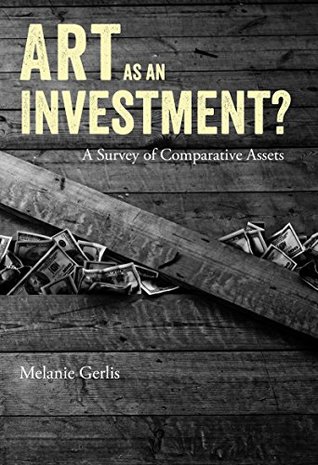Download Art as an Investment?: A Survey of Comparative Assets - Melanie Gerlis file in ePub
Related searches:
The third category, art investment services, is still in its infancy. It finds its source in the growing recognition of art as a new alternative asset class and supports the development of art investment products, the role of art to positively diversify investment portfolios and the integration of art into wealth portfolio analysis.
A survey of comparative assets - kindle edition by gerlis, melanie. Download it once and read it on your kindle device, pc, phones or tablets. Use features like bookmarks, note taking and highlighting while reading art as an investment.
Follow the author similar authors to follow art as an investment.
Art investment funds have fared well in poor economic climates and the art markets in general, managed to outperform the stock market throughout the 2001 recession. There are an estimated 72 funds in operation in june 2014 when deloitte and arttactic combined to take at look at the performance of these different funds.
The conclusion about art as an investment is clear: when we compared the investment returns and risk of all the styles of art to a portfolio of pure stocks, we found that art investments would not substantially improve the risk/return profile of a portfolio diversified among traditional asset classes, such as stocks and bonds.
Art in the overall asset allocation strategy art as an asset is attractive over the long run as it is a store of value that generates moderate positive real return. Art has also a low correlation with stocks and bonds which offer diversification possibilities. New types of collective investment vehicles dedicated to art or other collectible assets.
A survey allows you to test the popularity of goods and services while locating what you're excelling at and identifying areas that need more work.
The art market's size is one of the things that has worked against art funds – the attempt to improve liquidity by pooling outside investment to acquire works. Philip hoffman, who heads the fine art fund group, tells the story of one institutional investor who wanted to put $2bn into his first fund, which represented around 80 times its total.
An art investment fund, similar to a mutual fund, engages in the buying and selling of works of art for profit. However, many art investment funds charge hefty management, storage, and insurance fees that can eat into your profits.
In fact, the report by capgemini and rbc wealth management devotes a whole article to the fact that art as an investment of passion has experienced significant growth in recent years, especially.
Melanie gerlis has been the art market editor of the art newspaper since 2006, reporting on auctions, art fairs and market news globally since then. She previously worked for ten years at rlm finsbury, a strategic communications and investor relations firm, advising investment banks, hedge funds and other financial services clients.
During a 2019 survey, 65 percent of collectors and 81 percent of art professionals stated that they bought art for a collecting purpose but with an investment view.
In the aftermath of the financial crisis of 2008, art dealers were urging those with assets to defend to look towards art's steadiness and dependability as a safe haven.
In this week’s episode of the arttactic podcast, melanie gerlis, art market editor for the art newspaper, returns to the podcast to discuss her newly released book, art as an investment? a survey of comparative assets. First, melanie explains how she examines the concept of art as an investment by comparing it to six other assets, including: gold, equities, wine, private equity, property and the luxury goods industry.
1 billion, according to the art basel and ubs global art market report 2020, the key industry report with the latest available figures. The us maintained its postion as the largest art market globally, with 44% of the global market share in 2019.
Investopedia surveyed affluent millennials to learn how this generation views investing, who taught them, and how that education influences where they spend, save, and invest. Investopedia’s affluent millennial investing survey has revealed.
During the survey, 65 percent of collectors and 81 percent of art professionals stated that they bought art for a collecting purpose but with an investment view.
It draws on extensive research and interviews with key players in these other markets, as well as the author's own experience, to clarify the specifics of art as an asset class. This timely book considers the growing importance attributed to art as an investment, testing the validity of claims about art's capacity to generate returns that.

Post Your Comments: